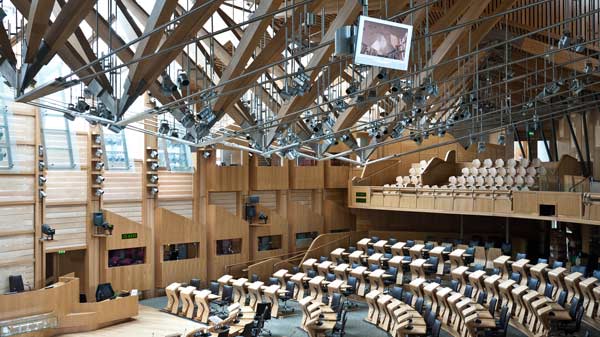The New Scottish Parliament
Wouldn’t you think that there has been a parliament continuously since Scotland became a country many centuries ago?
It’s a natural question to ask – and indeed the first recorded reference to a meeting of the Scottish parliament dates from 1235 and the first permanent meeting place for the parliament was established in 1632.
However, in the late 1600s Scotland made a huge blunder when it chose Panama as the setting for its colonial expansion. Scotland was already in trouble financially, and establishing a colony abroad seemed like a good idea.
After all, Spain, Portugal, the Netherlands, and of course England had tried and succeeded at it.
And Scotland didn’t want to be left further behind in the heady days at the end of the 17th century when the European world was snapping up colonies all around the globe.
Unfortunately, the Panama isthmus was a terrible choice for Scotland’s venture. It was cut off from the rest of Latin America by the Darien Gap (still a treacherous swampy area today) and trade was a failure while disease was widespread. The Spanish who were busy claiming Latin American for themselves weren’t too friendly either.
The Scots had originally secured investment for the colony from international backers but when England leaned on the backers to withdraw, the Scots turned to their own people to raise the capital.
When the venture failed, the investment was lost and Scotland was more or less bankrupt.
At which point England kindly offered to pay off Scotland’s debts in return for political union.
When I first learned of this jewel of history, I thought of the analogy of a forced marriage with the aged groom paying off the beautiful bride’s debts in return for her hand in marriage.
The Act Of Union
Whatever the truth of the way the union came about, by 1707 England and Scotland became the United Kingdom and that was the end of the Scottish Parliament for the best part of 300 years.
The situation changed with a referendum in 1979 that set the scene for the UK Parliament to devolve power to a Scottish Assembly.
The first elections to the Scottish parliament were held in 1999 and in September of that year the first Bill was presented to it.
Constitutional Arguments
Because the Scottish Assembly was created under devolved powers that issued from the Parliament in Westminster, it does not have power over areas such as foreign policy and defence.
And there are constitutional arguments about whether the United Kingdom parliament could withdraw the legislation that has given Scotland its Assembly.
The argument runs that because the Scottish parliament was created by devolved legislation its power could be taken away under the principle that that which has been devolved may be reclaimed.
Frankly, I cannot see many Scots standing for that argument, and it seems to me that the likely direction is for further devolution.
Time will tell…
The Cost Of Building The Parliament
In 2003, Lord Fraser of Carmyllie QC was appointed to find out what went wrong with the project to construct the new building designed to house the Scottish Parliament.
He was appointed to find out how the cost rose from the 1997 estimate of somewhere between £24 million and £44 million to its eventual cost of £430 million in 2004.
The Site
Several locations were originally suggested for the new building, but eventually the Parliament was constructed on a piece of land at the bottom end of the long street at the other end of which is Edinburgh Castle and the Royal Mile.
The Palace of Holyrood, where the Queen lives when she is in Scotland, is also at the bottom of this street.
And the new Parliament building is directly across the street from the palace.
I can just imagine someone in Holyrood peering from behind the net curtains, and looking across at the Parliament as it was being built and lamenting the blot on the landscape. Or perhaps not.
Actually, there is something very fitting about the home of the constitutional monarch being located directly opposite the elected parliament. It’s a kind of checks and balances building arrangement with the monarch and the elected representatives facing one another.
Arthur’s Seat
However they are arranged, the Palace of Holyrood and the Parliament building are both dwarfed by Arthur’s Seat – the main crag of a small range of hills that together form the bulk of Holyrood Park.
Arthur’s Seat is 800 feet (250m) tall and is the remains of a volcano, now long extinct and covered in grass.
It is usually dotted with the tiny figures of people walking to the top – as we did a year and a half ago now.
And it is just a short distance from Holyrood House and the Parliament.
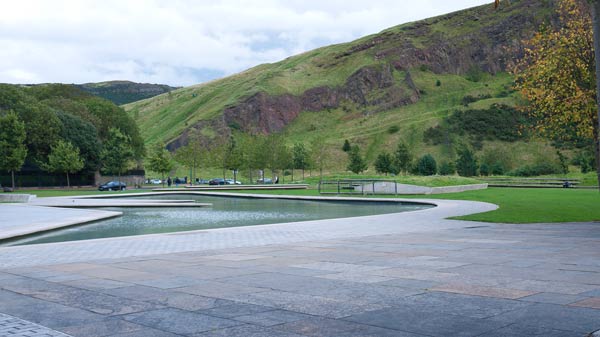
The Conclusion Of the Enquiry Into The Cost Of The Building Works
Lord Fraser concluded that the original estimate for the cost of building the Parliament was unrealistic given the very complex design envisaged by the Catalan architect Enric Miralles.
Miralles did not live to see the building work completed as, sadly, he died of a brain tumour in the year 2000, aged only 45.
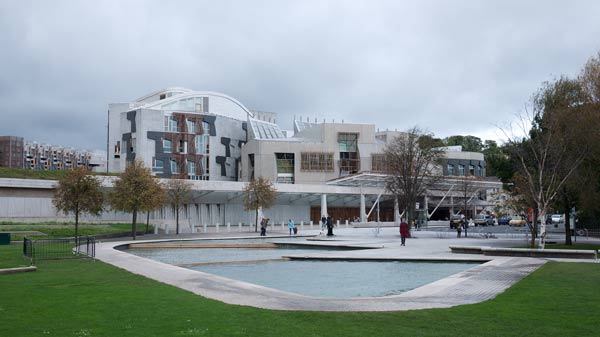
Opinions On Architecture
To take a slight detour on the subject of architecture, this summer we went to several events at the Edinburgh Book Festival.
One event that we went to was entitled Architecture In The Ruins given by two critics of architecture – Miles Glendinning and Owen Hatherley.
In its own words, the event:
sets out to excavate the architectural wreckage created by an age of greed. It provides a coruscating attack on an era of iconic buildings and ‘signature’ architecture.
Owen Hatherley has travelled up and down Britain looking for bad architecture.
I was heartened when he had a few choice words to say about the soulless buildings that have sprung up in the center of Leeds (where Tamara and I are living now).
He illustrated his talk with slides and I remember how he ridiculed the kind of building that is covered in fake balconies only inches deep that are supposed to add special status value to poorly designed blocks of flats.
He railed against Councils that sold development sites to developers for pennies. The developers then built monstrosities with fake appeal and small rooms that sold at inflated prices.
Signature Architecture
The attack on ‘signature architecture’ struck a chord with me.
Signature architecture means the kind of building that shows off how talented and individual the architect is, but which produces a building that bears no relationship to the environment in which it is situated.
And that is a fair criticism to level at the Parliament building.
Things I Like
There are a lot of things that I like about the building. For instance, the colors are very attractive. The metal and concrete are light in color but the metal has been brushed so that it isn’t blindingly shiny.
The building is low and made up of lots of interacting elements, so it doesn’t just sit there like a lump that repels all comers.
Instead, its low and scattered profile seems fitting for a parliament that is supposed to represent the people rather than lord it over them.
And there is lots of repetition of detail that ties the whole building together.
You can see the repeat pattern near the windows in the photographs below. The pattern is supposed to echo the lecterns at which representatives speak. And I can see that acting as a reminder to MPs that their job is to take part – to speak and argue and agree.
Sketches Of Spain And Mexico
But the fact is that parts of the front are covered with wooden sticks about two inches thick that have nothing to do with Scottish architectural styles.
They reminded me instantly of a Mexican hut. In my mind’s eye I ‘saw’ a connection with the Catalan heritage of the architect. From there I quickly imagined Miralles on vacation as a teenager in the south of Spain or in Mexico, admiring the rough peasant huts with branches and twigs covering the verandahs out front.
Still, I don’t object to the idea of there being a connection with peasant huts because the parliament building is a building for representatives of the people to meet and discuss matters. Better that than something grand and superior.
If you detect my ambivalence, you are right. I like the building and at the same time I think the wooden sticks are faintly ridiculous. But I like the ridiculousness of it. It raises a smile and perks me up.
I could happily go to look at the building again. It is pleasant. Perhaps that is the bottom line.
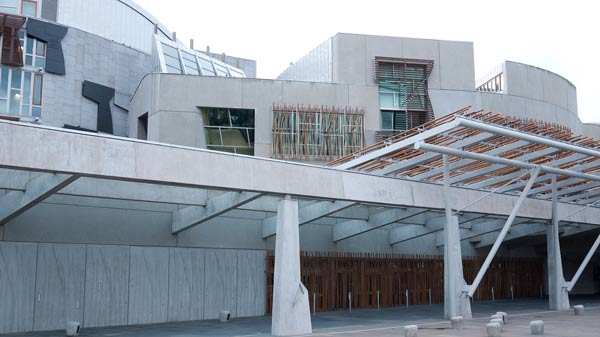
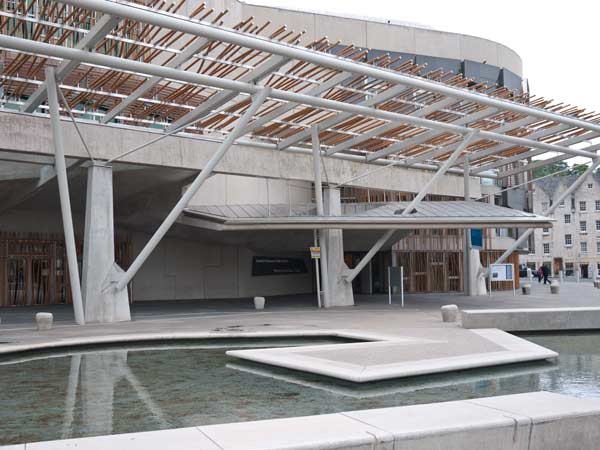
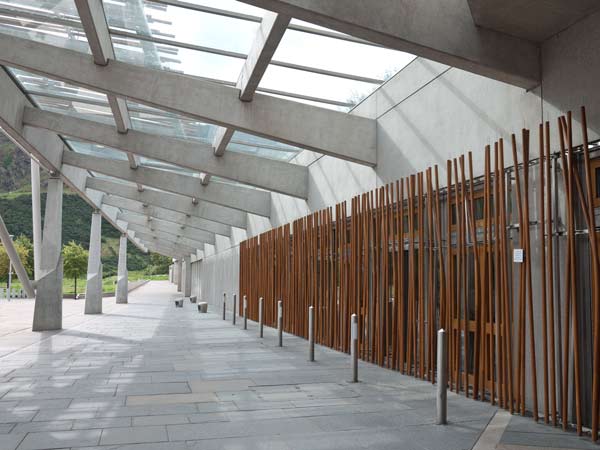
In The Debating Chamber
The inside of the building gets my vote. The first thing I noticed is that the seats in the debating chamber are not arranged in two sets of opposing rows like in the House Of Commons in London. Instead the seats are arranged in a collective circle around the speaker.
Of course, the politics may be just as divisive and wasteful as Westminster politics, but the debating chamber, at least, does not encourage it.
Conclusion
So that is my take on the Parliament building. It attracts many visitors and there are free tours of the smaller committee rooms.
Tamara encouraged me to be as enthusiastic as she was to take the tour and I am glad we did. She was right – it’s a great way to see parts of the building that casual visitors are unlikely to see otherwise.
